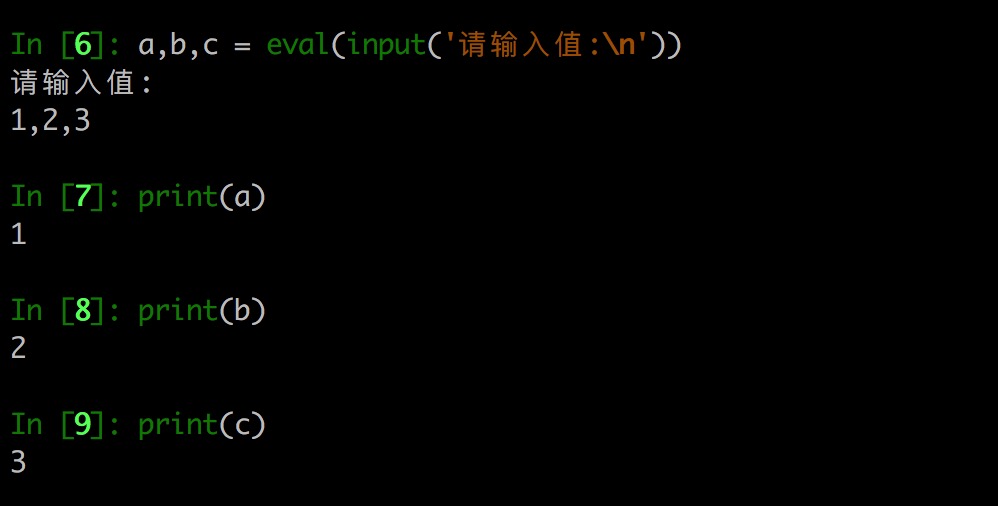Python-控制台输入输出
一 、输入
1、说明
输入输出,简单来说就是从标准输入中获取数据和将数据打印到标准输出,常被用于交互式的环境当中,Python中 input()来输入标准数据
2、语法格式
格式:input()
功能:接受一个标准输入数据,
返回:返回string类型。ctrl+z结束输入
3、示例代码
等待一个任意字符的输入
1
input('请输入用户名:\n')

接受多个数据输入,使用eval()函数,间隔符必须是逗号
1
a,b,c=eval(input())

二、输出
1、说明
Python一共有两种格式化输出语法。
一种是类似于C语言printf的方式,称为 Formatting Expression
一种是类似于C#的方式,称为String Formatting Method Calls
2、格式化输出
1、整数的输出
语法说明
格式化符号格式 说明 备注 %o 八进制 oct %d 十进制 dec %x 十六进制 hex 举个栗子
1
2
3
4
5
6print('%o' % 20) # 八进制
24
print('%d' % 20) # 十进制
20
print('%x' % 24) # 十六进制
18
2、浮点数输出
语法说明
格式化符号 说明 备注 %f 保留小数点后面六位有效数字 %e 保留小数点后面六位有效数字 %g 在保证六位有效数字的前提下,使用小数方式,否则使用科学计数法 举个栗子
1
2
3
4
5
6
7
8
9
10
11
12
13
14print('%f' % 1.11) # 默认保留6位小数
1.110000
print('%.1f' % 1.11) # 取1位小数
1.1
print('%e' % 1.11) # 默认6位小数,用科学计数法
1.110000e+00
print('%.3e' % 1.11) # 取3位小数,用科学计数法
1.110e+00
print('%g' % 1111.1111) # 默认6位有效数字
1111.11
print('%.7g' % 1111.1111) # 取7位有效数字
1111.111
print('%.2g' % 1111.1111) # 取2位有效数字,自动转换为科学计数法
1.1e+03
3、字符串输出
语法说明
格式化符号 说明 备注 %s 字符串输出 string %10s 右对齐,占位符10位 %-10s 左对齐,占位符10位 %.2s 截取2位字符串 %10.2s 10位占位符,截取两位字符串 举个栗子
1
2
3
4
5
6
7
8
9
10
11
12print('%s' % 'hello world') # 字符串输出
hello world
print('%20s' % 'hello world') # 右对齐,取20位,不够则补位
hello world
print('%-20s' % 'hello world') # 左对齐,取20位,不够则补位
hello world
print('%.2s' % 'hello world') # 取2位
he
print('%10.2s' % 'hello world') # 右对齐,取2位
he
print('%-10.2s' % 'hello world') # 左对齐,取2位
he
3、Formatting方法
相对基本格式化输出采用‘%’的方法,format()功能更强大,该函数把字符串当成一个模板,通过传入的参数进行格式化,并且使用大括号‘{}’作为特殊字符代替‘%’
1、基本用法
不带编号,即“{}”
1
2print('{} {}'.format('hello','world')) # 不带字段
hello world带数字编号,可调换顺序,如: “{1}”、“{2}”
1
2
3
4
5
6print('{0} {1}'.format('hello','world')) # 带数字编号
hello world
print('{0} {1} {0}'.format('hello','world')) # 打乱顺序
hello world hello
print('{1} {1} {0}'.format('hello','world'))
world world hello带参数,即“{a}”、“{b}”
1
2print('{a} {b} {c}'.format(tom='hello',a='world' ,c='python')) # 带参数
world hello
2、进阶用法
<(默认)左对齐、>右对齐、^中间对齐、=(只用于数字)在小数点后进行补齐1
2
3
4
5
6print('{}{}'.format('hello','world')) # 默认左对齐
helloworld
print('{:10s} and {:>10s}'.format('hello','world')) # 取10位左对齐,取10位右对齐
hello and world
print('{:^10s} and {:^10s}'.format('hello','world')) # 取10位中间对齐
hello and world取位数“{:4s}”、”{:.2f}”等
1
2
3
4print('{} is {:.2f}'.format(1.123,1.123)) # 取2位小数
1.123 is 1.12
print('{0} is {0:>10.2f}'.format(1.123)) # 取2位小数,右对齐,取10位
1.123 is 1.12
4、其它
1、自动换行
1 | print (1) |
2、不换行
1 | for i in range(0,3): |
5、format与%方式的优点
- 不需要理会数据类型 (python3以上的版本都是可以用%s)
- 单个参数可以多次输出,参数顺序可以不同
- 填充方式十分灵活,对齐方式异常强大
- 官方推荐用的方式,%方式在后面的版本终将会被淘汰